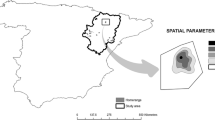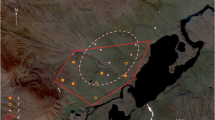Abstract
From 2003–2006, research on the breeding distribution of the white-tailed eagle (Haliaeetus albicilla) was conducted in Croatia in order to assess the size of the national population. In 125 locations, clear signs of breeding activity were found. An additional 10 presumably active territories were detected but it was not possible to locate the exact position of the nests and confirm the breeding. Based on this, it is concluded that the national breeding population is not less than 135 breeding pairs. The present distribution can be compared with previous reports with the exception of the area along the Ilova and Lonja rivers that have never been reported as an important breeding site. Analysis of the characteristics of 138 nest positions as well as preferences/avoidance of specific structural features were performed. The results showed that white-tailed eagles prefer to build their nests on pedunculate oaks, narrow-leafed ash and white poplars with the greatest preference for mature trees with a diameter above 92.5 cm. The minimal distance between two active pairs was 348 meters. More than 50% of the national population breed less than two km from a large water area and 95% of the population less than four km. More than 95% of the population breed at altitudes lower than 140 m above sea level and are further than one km away from the nearest human settlement, regardless of the availability of forests. According to several parameters (distance to a large water area, elevation, forest presence, distance to the nearest settlement, distance to highways and railways) geographic information system (GIS) helped to determine potential white-tailed eagle breeding areas.
Similar content being viewed by others
References
Andersen D.E., Rongstad O.J. & Mytton W.R. 1986. The behavioral response of red-tailed hawk to military training activity. Raptor Res. 20: 65–68.
Andersen D.E., Rongstad O.J. & Mytton W.R. 1990. Home range changes in raptors exposed to increased human activity levels in south-eastern Colorado. Wildl. Soc. Bull. 18: 134–142.
Andrew J. & Mosher J.A.1982. Bald Eagle nest site selection and nesting habitat in Maryland. J. Wildl. Manag. 46: 383–390.
BirdLife International. 2004. Birds in Europe: Population Estimates, Trends and Conservation Status, BirdLife International, BirdLife Conservation Series No. 12, Cambridge, 374 pp.
Boeker E.L. & Ray T.D. 1971. Golden eagle population studies in the Southwest. Condor 73: 463–467.
Block W.M. & Brennan L.A. 1993. The habitat concept in ornithology. Theory and applications, pp. 35–91. In: Power D.M. (ed.), Current Ornithology 11, Plenum Press, New York.
Brown L. & Amadon D. 1968. Eagles, Hawks and Falcons of the World. Vol. 1. McGraw-Hill, New York, 945 pp.
Casagrandi R. & Gatto M. 2002. A persistence criterion for metapopulations. Theor. Popul. Biol. 61: 115–125. DOI 10.1006/tpbi.2001.1558
Cramp S. (ed.) 1982. The Birds of Western Palearctic. Vol. II. Oxford University Press, 695 pp.
Crkvenčić I. (ed.) 1974. [Geography of Croatia — Middle part]. Vol. I. Školska Knjiga, 220 pp. [in Croatian]
Crkvenčić I. (ed.) 1975. [Geography of Croatia — Eastern part]. Vol. III. Školska Knjiga, 256 pp. [in Croatian]
Depoli G. 1928. La provincia Carnaro. Rijeka, pp. 124–126.
Fretwell S.D. & Lucas H.L. 1970. On territorial behaviour and other factors influencing habitat distribution in birds I. Theoretical development. Acta Biotheor. 19: 16–36.
Glutz von Blotzheim U.N., Bauer K.M. & Bezzel E. 1971. Handbuch der Vögel Mitteleuropas. Band 4, Falconiformes. Akademische Verlagsgesellschaft, Frankfurt am Main, 943 pp.
Grubb T.G. & King R.M. 1991. Assessing human disturbance of breeding bald eagles with classification tree models. J. Wildl. Manag. 55: 500–511.
Hansen K. 1979. Status over bestande (Haliaeetus albicilla groeanlandicus Brehm) i Grönland i årene 1972–1974. Dansk. Orn. Foren. Tidsskr. 73: 107–130.
Hauff P. 2001. Horste und Horstbäume des Seeadlers Haliaeetus albicilla in Mecklenburg-Vorpommern. Ber. Vogelwarte Hiddensee 16: 159–169.
Helander B. 1985. Reproduction of the white-tailed sea eagle (Haliaeetus albicilla) in Sweden. Holarct. Ecol. 8: 211–227.
Helander B. 1994. Pre-1954 breeding success and productivity of white-tailed sea eagles (Haliaeetus albicilla) in Sweden, pp. 731–733. In: Meyburg B.-U. & Chancellor R.D. (eds), Raptor Conservation Today, Proceedings of the IV World Conference on Birds of Prey and Owls, WWGBP & Pica Press.
Helander B. & Stjernberg M. 2002. Action Plan for the Conservation of the White-tailed Sea Eagle (Haliaeetus albicilla). BirdLife International and Conseil de l’Europe, Strasbourg, 43 pp.
Horvath Z. & Pinter T. 2005. Nest site selection of Hungarian white-tailed eagles (Haliaeetus albicilla) according to a survey made in 2000. Aquila 112: 23–32.
Janes S.W. 1985. Habitat Selection in Raptorial Birds, pp. 159–188. In: Cody M.L. (ed.), Habitat Selection in Birds, Academic Press Inc., Harcourt Brace Jovanovich, New York.
Katzner T., Milner-Gulland E.J. & Bragin E. 2007. Using modeling to improve monitoring of structured populations: Are we collecting the right data? Conserv. Biol. 21: 241–252.
Kollmann R., Neumann T. & Struwe-Juhl B. 2002. Population and conservation of the white-tailed eagle (Haliaeetus albicilla) in Germany and neighbouring countries. Corax 19(1): 1–14.
Krebs C.J. 1999. Ecological Methodology. 2nd Ed. Addison-Welsey Educational Publ., Menlo Park, California, USA, 620 pp.
Livingston S.A., Todd C.S., Krohn W.B. & Owen R.B. Jr. 1990. Habitat models for nesting bald eagles in Maine. J. Wildl. Manag. 54: 644–653.
Love J. 1983. The return of the Sea Eagle. Cambridge University Press, Cambridge, London, New York, 227 pp.
Lőhmus A. 2001. Selection of foraging habitats by birds of prey in north-western Tartumaa. Hirundo 14: 27–42.
McEwan L.C. & Hirth D.H. 1979. Southern Bald Eagle productivity and nest site selection. J. Wildl. Manag. 43: 585–594.
Mizera T. 1999. White-tailed Eagle. Monografie Przyrodnicze Nr 4. PT-Druk, Swiebodzin, 195 pp.
Mizera T. 2002. Population development and conservation of the white-tailed eagle in Poland in the 20th century. Corax 19(1): 85–91.
Mori S. 1980. [Breeding biology of the white-tailed sea eagle Haliaeetus albicilla in Hokkaido, Japan]. Tori 29: 47–68. [In Japanese, English Summary]
Morrison M.L. & Pollock K.H. 1997. Development of a Practical Modelling Framework for Estimating the Impact of Wind Technology on Bird Populations. California State University, Sacramento, 29 pp.
Olsson V. 1972. Revir, biotop och boplatsval hos svenska havsörnar (Haliaeetus albicilla) [Territory, habitat and nestsites of Swedish white-tailed eagles (Haliaeetus albicilla)]. Vår Fågelvärld 31: 89–95.
Probst R. 2002. Population development and conservation of the white-tailed eagle (Haliaeetus albicilla) in Austria. Corax 19(1): 92–95.
Prochazka J. 2002. Population development, distribution and some aspects of the conservation of the White-tailed Eagles in the Czech Republic. Corax 19(1): 96–101.
Radović D., Kralj J., Tutiš V. & Ćiković D. 2003. [Red book of Endangered Birds in Croatia]. Ministry of Environmental Protection and Physical Planning, 179 pp. [in Croatian]
Radović D. & Sušić G. 1997. Pripombe na nerisnice navedene v članku g. Petra Trontlja Ignoranca birokratskega aparata (IBA). Acrocephalus 18: 80–81.
Randla T. 1976. White-tailed eagle Haliaeetus albicilla and Golden Eagle Aquila chrysaetus in Estonia. Ornis Fennica 53: 125–127.
Rucner D. 1998. [Birds of Croatian Part of Adriatic]. Croatian Natural History Museum, 311 pp. [in Croatian]
Schneider-Jacoby M. 1996. Brutbestand des Seeadlers (Haliaeetus albicilla) und des Schreiadlers (Aquila pomarina) in den Save-Auen (Kroatien), pp. 149–163. In: Eagles Studies, World Working group of Birds of Prey, Berlin-London-Paris
Schneider-Jacoby M. 2003. Lack of ferruginous duck protection in Croatia: a reason for the decline in Central Europe?, pp. 44–53. In: Petkov N., Hughes B. & Gallo-Orsi U. (eds), Ferruginous Duck: From Research to Conservation, BirdLife International-BSPB-TWSG, Conservation Series No. 6., Sofia.
Schneider-Jacoby M. 2005. The Sava and Drava floodplains: Threatened ecosystems of international importance. Large Rivers 16(1–2): 249–288.
Schneider-Jacoby M., Mohl A. & Schwarz U. 2003. The white-tailed eagle in the Danube River Basin, pp. 133–140. In: Helander B., Marquiss M. & Bowermann W. (eds), Sea Eagle 2000, Swedish Soc. For Nature Conservation/SSF and Atta, Stockholm.
Shiraki S. 1994. Characteristics of White-tailed Sea Eagle Nest Site sin Hokkaido, Japan. The Condor 96: 1003–1008.
Stalmaster M.V. & Kaiser J.L. 1998. Effects of recreational activities on wintering bald eagles. Wildl. Monogr. 137: 1–46.
Stalmaster M.V. & Newman J.R. 1978. Behavioral responses of wintering Bald Eagles to human activity. J. Wildl. Manag. 42: 506–513.
Struwe-Juhl B. 2002. Age-structure and productivity of a German white-tailed sea eagle (Haliaeetus albicilla) population. Corax 19(1): 51–61.
Thompson C.M. & McGarigal K. 2002. The influence of research scale on bald eagle habitat selection along the lower Hudson River, New York (USA). Landsc. Ecol. 17: 569–586.
Tobish T.G. Jr. & Balch L.G. 1987. First North American nesting and occurrence of Haliaeetus albicilla on Attu Island, Alaska. Condor 89: 433–434.
Tucker G.M. & Heath M.F. 1994. Birds in Europe: Their Conservation Status. BirdLife International, Birdlife Conservation series No. 3, Cambridge, U.K, 600 pp.
Wiley J.W. 1975. The nesting and reproductive success of red tailed hawks and red shouldered hawks in Orange County, California. Condor 77: 133–139.
Author information
Authors and Affiliations
Corresponding author
Rights and permissions
About this article
Cite this article
Radović, A., Mikuska, T. Population size, distribution and habitat selection of the white-tailed eagle Haliaeetus albicilla in the alluvial wetlands of Croatia. Biologia 64, 156–164 (2009). https://doi.org/10.2478/s11756-009-0011-0
Received:
Accepted:
Published:
Issue Date:
DOI: https://doi.org/10.2478/s11756-009-0011-0




